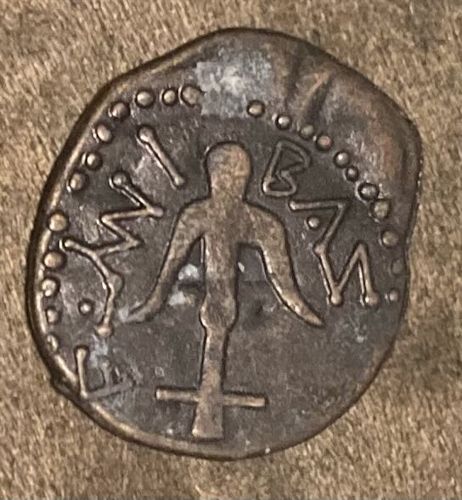Byzantine Follis (possibly Anonymous Follis)
Country of Origin: Byzantine Empire
Year of Issue: Circa 10th-11th century AD (specifically, likely Class A2 or A3, c. 976-1081 AD)
Denomination: Follis
Composition: Bronze/Copper

Brief Description
The coin features a standing figure, likely an emperor or Christ, with a nimbus (halo) behind the head and holding a labarum or long cross, and possibly an orb. The figure is flanked by Greek inscriptions, often debased or abbreviated. The reverse typically bears a three-line legend. The coin's overall appearance is irregular in shape and strike, common for Byzantine coinage of this era.
Historical Significance
Anonymous Folles are significant as they represent a shift in Byzantine coinage policy. Unlike earlier issues that featured the reigning emperor, these coins depict religious imagery (specifically Christ Pantocrator or standing figures of Christ/Virgin Mary) without the emperor's portrait. This change is often interpreted as a move to assert the emperor's piety and divine right to rule, or perhaps to depersonalize the coinage during periods of political instability. These coins were the staple currency for everyday transactions in the vast Byzantine Empire for over a century.
Estimated Value
Due to their commonality and often poor preservation, most Anonymous Folles in circulated condition are valued between "$20" and "$100". Higher grades or rare varieties can fetch more, potentially in the "hundreds of dollars". The exact value depends heavily on the specific class, condition, and clarity of the details.
Care Instructions
Handle the coin by its edges to avoid transferring oils from your skin. Store it in a cool, dry place, ideally in a non-PVC coin holder or slab to prevent environmental damage and further corrosion. Cleaning is generally not recommended, as it can devalue ancient coins; a stable patina is often preferred by collectors.
Created At: 2025-09-30T14:46:29.617806